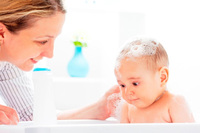Safety tips to stop bath-time scalding

As the cold weather has set in, bath-time for children remains one of the most important part of a child's day - not only to keep them warm, but also to help children learn about bath water safety and spend valuable family bonding time together - which is why Megaflo, the hot water experts, has created these top ten bath-time safety tips to help parents keep their kids safe in the bath.
Though 94% of parents admit that children's' bath time is essential to help them relax and learn about bath water safety startling figures show each year emergency departments in the UK see around 2,000 cases of bath water scalds causing severe scalding in children. It takes less than a second for a child to be severely scalded by hot water. Bath time can also present other potential hazards for your child, which is why Megaflo, the hot water experts have put together some top tips for parents to follow while bathing their children.
1 Temperature Control
Getting the right temperature for your child is of optimum importance make sure you have a Thermostatic Mixing Valve (TMV) fitted and manage the temperature of your water. Fill the bath tub with cold water first, and then add hot water, this will reduce the possibility of your baby getting scalded. The temperature for young children should be around 37° centigrade. Use your elbow to test the temperature and give the water a good swirl to ensure even heating.
2 Constant Supervision
The fundamental baby-bathing rule is to never leave your little one unsupervised. Children can drown in less than just an inch of water so make sure you have all your supplies (soap, towel and toys) at the tub already. And if the doorbell chimes or the phone rings, scoop your baby up in a towel and take them with you. Little inquisitive fingers can also be attracted to the tap so it'd essential you keep an eye on them at all times.
3 Depth
Drowning can occur in just an inch of water so never fill the tub more than waist-high when your child is sat up.
4 Run the bath before your little one gets in
Never put your child in the tub while the water is still running; the water temperature could quickly change or the water could get too deep.
5 Safety seats and bath mats
Make the family tub safe by using a rubber bath mat for more secure seating while in the tub to prevent your child from sliding under the water and have a bath mat with a non-skid bottom next to the tub to prevent slipping and sliding.
6 Keep danger out of reach
Medications, cleaning supplies and electric appliances are just a few of the hazards that are usually stored in bathrooms. Make sure such items are stored up high or secured in a locked cabinet where children can't reach them. Only rubber ducks and other playtime goodies should be near the bath when your baby's bathing.
7 Faucets away
Keep those fingers away from the faucets- even if he can't move them now he'll be strong enough to do so eventually so try sitting your child facing away from the faucets to resist temptation. A cushioned spout cover can also protect your child's head from painful bumps.
8 Soapy suds
Soaps, shampoos, and bubble baths can dry your baby's skin and may cause rashes, so use them sparingly. To avoid having your baby sit too long in potentially irritating soap-filled water, have playtime at the beginning of the bath and save the soap and shampoo for the end.
9 Bathroom temperature
Make sure the bathroom is comfortably warm (around 23° centigrade) as children can get chilled quickly.
10 Drain away
Let the bath water out as soon as bath time is over to prevent any siblings or family pets of having an accident.
For more information, visit megaflo.com.

